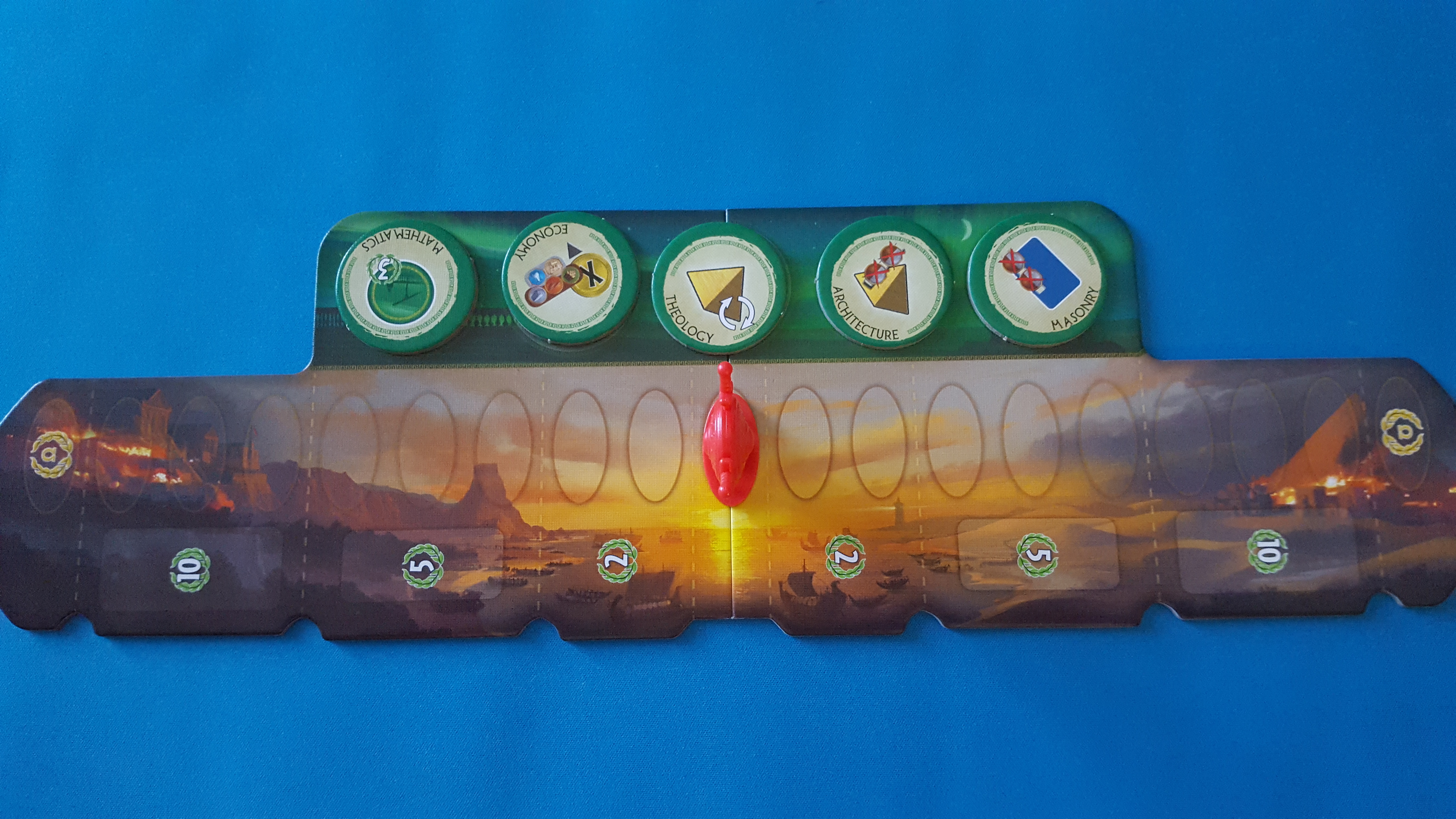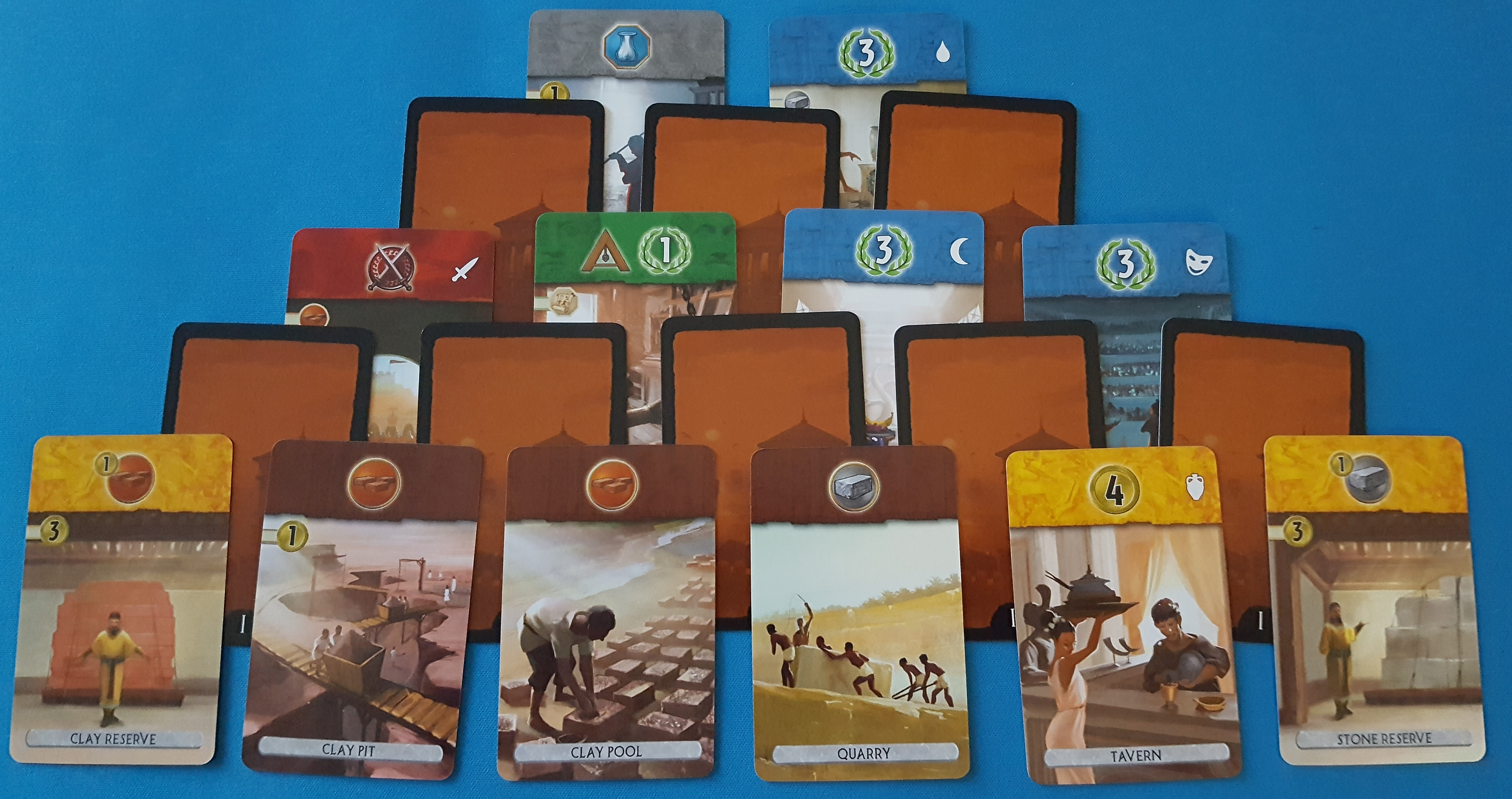Two Player Showcase – Jaipur, 7 Wonders Duel, Honourable Mentions
September 1, 2017
Jaipur has each player trying to become the richest trader by collecting, exchanging and ultimately selling, goods cards at the market. There are six different types of goods. Diamonds, gold, silver, cloth, spice and leather. They make up the game’s deck of cards, along with a whole desert full of camels.

Goods types and CAMELS
The market always consists of five faceup cards from the deck. On a player’s turn, they can take cards or sell cards, but never both. A player can take cards in three ways. They can choose a single goods card from the market and add it their hand. They can exchange any number of goods cards from the market with the same number of camel cards from their herd. Or, they can take all of the camel cards in the market and add them to their herd.
A player’s herd is kept on the table in front of them, with no limit to the number of camels a player can have in it. The herd is kept separate from a player’s hand. The hand has a limit of seven goods cards. At the end of a player’s turn, any empty spaces in the market are filled from the top of the deck.
When a player sells goods, they choose any number of matching cards from their hand and discards them, collecting the same number of goods tokens. Ex. Player A takes three cloth cards from their hand and discards them, taking the top three matching cloth tokens.
The goods tokens decrease in value and are arranged from highest to lowest. When three types of goods tokens are depleted, the game ends. The game can also end if the market deck ever runs out. At that point, each player adds up the value of their collected tokens. The player with the largest herd gains a five point bonus token. Whoever has the highest combined value wins the round and gains a Seal of Excellence. When a player gains two Seals of Excellence, they are declared the winner.

Goods tokens
Jaipur is a very simple set collecting game. Take some cards, sell some cards. See what new cards come from the deck that your opponent now gets first crack at. That’s basically the game. The diamonds, gold and silver being the ones to go for since the corresponding goods tokens start at a higher value and don’t depreciate as drastically as cloth, spice and leather. But you have no idea when those precious goods will come up since the market is refilled from a shuffled deck of cards.
Every action players take in this game is solely devoted to mitigating that randomness. But nothing they do can really swing it in their favour. Instead, their actions serve to decrease the chances of a market filling with precious goods for their opponent.
Let’s start with the camels. Man I love getting those damn camels into my herd! I have no idea why, but when I see two or more camels in the market, I can’t resist grabbing them. When I do, that puts two or more fresh goods into the market for my opponent to get first crack at. That’s not always entirely bad to do though. Just because three gold cards came up to replace those stinky camels I just grabbed doesn’t mean my opponent can snatch them up.
I have to pay attention to how big their herd is, and how many cards they have in their hand too. No camels? No problem! They can only take a max of one card from the market without them. A full seven cards in their hand? Wicked! That means they have no choice but to sell on their turn, leaving me to use those newly herded camels to hoard all of that gold!
Those are all best case scenarios, obviously, and rarely happen. But maybe those camels are really your only half decent play, what do you do? Well, you have to bet on how much better that play is for your opponent. You may have to sell off one worn out leather or spice, just to stall. Throwing that decision back to your opponent to make, to hopefully set you up for a better market on your next turn.
Of course, there’s nothing stopping your opponent from doing the same thing to you. Then you to them, them to you, you to them. Well eventually those goods tokens will run out. And it only takes those three lower valued goods tokens to run out before it’s game over. There are some other rules I didn’t mention above that also help keep this from happening, giving the players more gameplay choices.
The precious goods, diamonds, gold and silver, all require a player to turn in at least two goods cards at a time when selling. So you can’t be stalling your turn and snagging up the highest valued goods tokens. And in addition to the goods tokens, the players can earn bonus tokens when selling.
If they sell three, four or five goods at a time, they get to take a random token from the corresponding numbered stack which give them additional points to score at the end of the round. So the game does reward you for going after the same type of goods. And that is really where the maximum hand size affects the game. It is very difficult to get five of the same good in your hand quickly. While you’re hoarding one type of good, your opponent is basically free to snag up anything that you aren’t. And potentially selling off the same good that you’re collecting, leaving you with the measly one point tokens at the bottom of the stack. Making all of your effort worth even less.
All of this mitigation can never fully remove the randomness of the draw deck, of course. Which is why I think you’re meant to play best of three rounds. And in my experience it usually does go the full three to find a winner. That winner is NEVER me though. I’m awful at this game! Those damn camels are my siren call! Luring me into the hot, sweaty desert, and away from the gleaming gold and shimmering diamonds of the market.
There’s a unique ebb and flow to this game as the camels seem to pass back and forth between players, one player’s hand is filling up just as the other’s is emptying out. I fully recommend giving this game a try. It’s quick and light, yet still offers the players interesting choices they need to make, adapting to the random market. But now Reader, it’s time to d-d-d-d-d-d-d-duel! 7 Wonders Duel!
7 Wonders Duel sees players leading a civilization, constructing buildings and wonders over the course of three ages. These ages take the form of cards, which are laid out in specific patterns at the beginning of each age. Some cards are placed face up and some cards are placed face down. Each age also has a unique configuration, as shown in the rulebook and on the excellent reference that comes with the game.
Before the game starts, the players select four wonders each. The wonders provide a variety of benefits once constructed, such as money, military might, end game victory points, etc. Speaking of which, having the most victory points at the end of the third age is one of the three win conditions. This is called a civilian victory. The other two are military supremacy and scientific supremacy. These last two can happen at any time and immediately end the game when they occur.
Military supremacy is achieved by moving the conflict pawn into your opponent’s capital city on the game board. The pawn moves when a player constructs a building, or wonder, that depict the shield icon.

Main game board with Conflict Pawn
Scientific supremacy is achieved when a player has gathered six of seven unique scientific symbols. These symbols are acquired from constructing buildings that depict the science symbols.
Players take turns constructing accessible cards from the age cards that have been laid out. A card is accessible if it is not covered by any part of any other card. Each card has a cost in the left hand corner and a benefit at the top of the card. This benefit is gained by the player that constructs that card. Most often, it will depict a resource type. Once constructed, you now have access to that resource so you can construct cards with higher costs.

Age I card array
Ex. In the first age, the bottom row of six cards are all accessible. One of them is the Clay Pool. It has no symbols on the left hand side, meaning that it is free to construct. At the top of the card is the clay resource symbol. On subsequent turns, I now produce one clay to use to construct buildings with the clay requirement.
If you do not have a resource that you require, you can trade for it by paying coins to the bank. If you have no money, you can choose an accessible card to discard from the age and gain coins. If you meet the requirements for the construction cost of one of your wonders, you also choose an age card to discard and place the constructed wonder in your play area, gaining any immediate benefits. You can also trade for goods when constructing your wonder. Once the seventh wonder has been constructed, that’s it! The last, unbuilt wonder is returned to the game box. Play continues until one of the three win conditions is achieved.
Of all the games I’ve covered in the Two Player Showcase, this is definitely the most involved. In ruleset and gameplay. If you’re familiar with regular 7 Wonders, you’ll obviously pick this one up very quickly since it shares the same iconography and basic gameplay. I always found it funny that 7 Wonders is considered a good drafting gateway game. I think it could be pretty overwhelming with all of the iconography everywhere. But like any other game, it quickly becomes self explanatory and it makes sense. And so does 7 Wonders Duel.
It plays surprisingly fast. You seem to get your engine revving up just in time for the third age to roll around, then it’s time to shut it down and count up points. But you definitely don’t ever get that engine firing on all cylinders, it kind of just chugs along, the occasional backfire making you jump a bit. You’re going to have to trade in this game, no doubt about it. I like that the cost to trade varies throughout the game, depending on the buildings in your opponent’s city. If they’ve scooped up all of the stone, you’re going to pay out the ass for it. They have the monopoly on it and can dictate the cost of the supply for your demand. You don’t actually pay your opponent though, it goes to the bank, which doesn’t really make sense to me. Though there is a progress token “economy” that makes it so your opponent does actually pay you when trading. The progress tokens are gained whenever you get two of the same science symbol. You randomly choose five of them during setup.
The military and scientific supremacy win conditions seem very important to the game. They bring a forced balance to the gameplay. Players have to pay attention to each other and can’t just play solitaire building their resource engine. This is a duel afterall! Say you ignore military cards for several turns, and your opponent has that conflict pawn three or four spaces forward. This has allowed you to focus on constructing other buildings that can set you up for future ages.
But you should probably do something about that military board though. While you invest the energy in constructing military buildings to bring that conflict pawn back down to the middle of the board, your opponents gets their chance to focus on other buildings that can increase their engine too.
Same with the science cards. Though these are a little different in how you can counterplay them. As far as the win condition goes, who cares if your opponent has three, four or even five of those science symbols? It’s all six or nothing for the win. So to keep that threat in check, you can build the odd science building, targeting ones with symbols your opponent needs. Or you can just straight up deny those symbols to anybody and discard the age card, gaining some mad coinage in the process! A nice big SUCK IT to your opponent.
The maximum of seven built wonders per game gives a nice race mechanic to get them built. Missing out on one of your wonder’s benefits could be pretty huge. And the best part is that you also get to play the denial game when you build them too! Fans of 7 Wonders definitely need this in their collection. It’s such a nice add on to that three to seven player count. Such versatility you could have! A game for all number of players! And what’s better than having a varied, accessible collection with a game for all types and all player counts?
To wrap everything up, I wanted to throw out some honourable mentions. I couldn’t talk about my favourite two player games and not mention Twilight Struggle. I’m sure you know all about this game Reader. If not FOR SHAME. This game is the epitome of tug of war. The card play is so much fun, having to give your opponent something good half of the time just to make an impactful play for yourself.
And that card play only gets better with repeated plays when you start to know which cards could come up that can totally screw you if played at the right time, and when to hold onto some cards so you can do the same thing to your opponent. I rarely play the USSR, because the main person I play with, Moby(one of the co-hosts on our podcast), just loves all things Russian. So I’m always playing the U.S. and we’ve both become pretty evenly matched against each other. I always end up winning though, he kind of sucks at games. U S A! U S A!
Twilight Struggle does have its challenges though. It can be difficult to teach. Specifically the importance of realignment rolls versus coups. A lot of this game is preparing for upcoming rounds since it’s difficult to impactfully react to a play your opponent just made. And when I say impactful, I mean impactful to your game plan. Usually, you have a good chance of undoing what your opponent has done, but then you’re spending all of your time reacting and not doing anything to further your own victory. It’s easy to get caught up in that, and it can be difficult for newer players to figure out the long term impacts of these moves until they see the results of them. But it can take half of the game before that happens.
There’s a really slick electronic version of Twilight Struggle that you should check out if you’re at all interested in this game and have never played it. Personally, I love it the most playing in person so I can trash talk the hell out of my opponent, threatening nuclear war after every move they make.
My next honourable mention is Patchwork. I really enjoy this game. It’s basically board game tetris with annoyingly weird shapes. And buttons! SO MANY BUTTONS! In my entire life, I have never said the word “button” as many times as I have while teaching the rules for this game. I love tile laying games, and that’s all you do in this game, trying to fill up the nine by nine grid of your player board. Any empty spaces left unfilled count as negative points at the end of the game.
The way tiles are selected is great too. They’re laid out in a circle, a player can buy any of the three tiles in front of the marker. Choose a tile, pay your buttons, move the marker to the empty space you just made by buying your tile. So you have some control over which tiles you make available for your opponent on their turn.
When you choose a tile, you’re not just looking for the right shapes to fill in your board, you need to get tiles that have buttons on them. These tiles generate button income for you, allowing you to buy more tiles in the future. So you may have to make the choice between the perfectly shaped tile for your board or a tile that has three buttons on it that can give you more financial flexibility later in the game. Not to mention, unspent buttons are also victory points at the end of the game.
Last, but definitely not least, I wanted to talk about Android: Netrunner. This is an asymmetrical living card game that offers a lot in the way of deck building choices and gameplay choices. One player takes the role as the Runner, trying to hack the other player’s, the Corporation’s, servers to uncover their hidden agendas before the Corp can complete them.
That’s a ridiculously simplified explanation of this game. There are a lot of little rules that only come up in certain situations, meaning players need to have a good grasp on the structure of gameplay and timing windows. A little similar to Magic the Gathering in that way. That rule structure opens up a lot of interesting design space though, allowing players to build decks around cards that apply to niche gameplay situations. With LCG’s and CCG’s, the most fun parts for me is the deckbuilding and the theory crafting.
The current state of the game is a little wonky right now as far as competitive play goes. But it’s really the perfect time to become a new player. A big bog expansion was recently released, Terminal Directive, that offers a ton of cards. You get that and a Core Set, you’re setup to play. Terminal Directive also has a legacy-ish campaign. I haven’t played it, but have heard good things. It would be a perfect introduction for new players. And rotation is happening in a couple of months, meaning a large chunk of the oldest cards will no longer be considered legal for tournament play, so the card pool is shrinking significantly. Which lowers the barrier to entry into the game, monetarily wise anyways.
There are a bajillion videos out there of pack reviews, deckbuilding theory, tournament games, and there are a ton of podcasts on the game too. Basically a ton of information out there if you’re so inclined to look into it. I would definitely suggest checking it out if it sounds interesting to you at all.
And that’s it, we made it! The end of the Two Player Showcase. I hope you enjoyed it and found some valuable information. I had a good time writing it! Thanks again Reader!
L.


